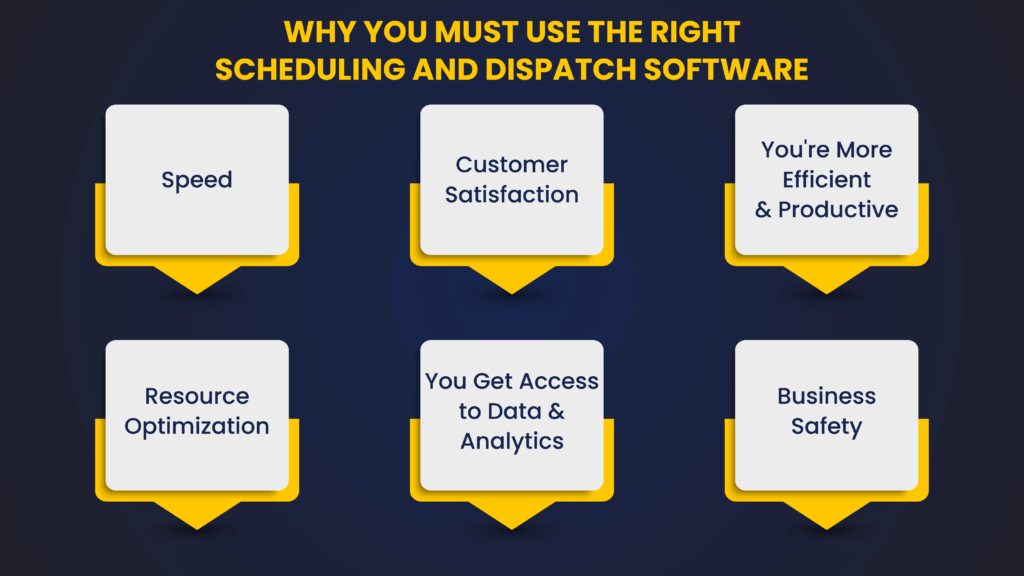Let’s start with the facts. The easiest way to cut costs in field service is by using digital technologies.
According to McKinsey, businesses handling logistics with dispatch management software save about 20% of operational costs. Imagine saving 20% for 5 years.
Besides a slash in operational costs, you have more reasons to use scheduling and dispatch software. This article highlights those benefits alongside the key features dispatch management software should have. That way, you can choose the best software for your business.
How Do You Handle Scheduling and Dispatch?
Dispatching is vital in field services where a company’s delivery team, including drivers and other personnel, conducts operational tasks at customer sites. The process involves assigning customer work orders to teams based on factors such as time of order, technicality, proximity, skill requirement, available staff, etc. In plain words, dispatch sends the right workers to the right jobs at the right time.
For any “sending” to occur, there must be scheduling. Scheduling ensures the accurate allocation of tasks and technicians. However, scheduling has several issues, as field service businesses may struggle with last-minute changes, miscommunications, or missed appointments.
Two Ways to Handle Scheduling and Dispatch
You can approach scheduling and dispatch in two ways: manual or automated. In manual dispatch, dispatchers assign tasks to technicians through phone calls, spreadsheets, and handwritten sticky notes. It’s familiar and cheaper for field service businesses with small clientele to hire a human dispatcher who handles scheduling, tracking, and customer service alone.
On the other hand, automated dispatch uses digital technology to perform these tasks. The dispatcher programs the software to do certain things at specific times.
Automated software allocates tasks and schedules technicians much faster with minimal human intervention based on their existing data. For instance, rather than calling field workers to see who is available for a specific job and then looking for a skill set that matches the work order request. The software also improves route planning, tracking, and updates.
The Problem With Manual Methods

Some of the most common issues with manual scheduling processes include unavailable time slots (when dispatchers are busy), wrong assigning, double-booking (assigning two field workers to one task), forgetting entries, and miscommunication.
You should avoid manual scheduling and dispatch in field service because of the following:
- It Has a High Risk of Human Error: This can lead to incorrect assigning, scheduling issues, delays, miscommunication, and mismanagement. Unfortunately, the slightest mistake can cost a business in cash and kind. For instance, assigning a task to the wrong field worker can result in poor service delivery, which is a shortcut to having unhappy customers.
- Slow Response Times: Dispatchers have to manually monitor drivers, allocate routes, and track compliant operations, which takes time and slows the process.
- Slows Down Scalability: Manual processes may fall apart as the business grows and operations expand. The larger your fleet, the harder it is to organize things by hand.
- It May Affect Customer Satisfaction: If excellent customer service leads to satisfied customers, poor scheduling and dispatching frustrates everyone involved (customers, technicians, field workers). Since customers expect reliable service, frequent mistakes are bad for business.
- Lack of Data Insights Makes it Harder to Improve: The best way to improve field workers’ efficiency is to track their performance, but doing this with humans is time-consuming. Manual procedures can’t track key performance indicators (KPIs). And when you fail to capture customer feedback, optimizing your operations and satisfying customers is harder.
- Employee Turnover: Poor scheduling and dispatch frustrate customers and make employees miserable. When tasks take longer to complete, field workers may face unpaid overtime.
You must prepare for chaos if you don’t use a streamlined system. Even worse, be ready to lose time, customers, employees, and money. Meanwhile, dispatch systems can use automation as an essential dispatch software feature to improve scheduling and dispatch.
Use scheduling and dispatch software – Provide top-notch service – Manage customers better – Retain customers – Get repeat business and referrals – Increase revenue
Automation Makes Scheduling and Dispatch Better
Every system has challenges and inevitable issues, but to make your business profitable, you must reduce them to the bare minimum. In this case, automation is your best bet. Scheduling and dispatch software eliminates guesswork, reduces admin work, and improves service efficiency.
An automated system can help you manage teams and processes, distribute resources, and balance workload.
For instance, top scheduling software features can automate assignments to field workers based on skill level, availability, traffic, location, and vehicle capacity. They can also choose the best routes and ensure workers get to the right place at the right time with the right information and tools.
Why You Must Use the Right Scheduling and Dispatch Software

It’s not logical to say manual processes or subpar software don’t work. Of course, they do. But should you use them when scheduling dispatch software to streamline operations and benefit business stakeholders, including customers, employees, and investors?
Here’s how automated field service scheduling software can help your business:
- Speed: When you assign tasks with real-time data, you swap errors for speed and accuracy. Fewer errors mean fewer incorrect assignments, faster service, and better workflow—no mistakes or mix-ups.
- Customer Satisfaction: Since automation ensures faster and better service, customers see you as a reliable business. Happy customers return, leave positive reviews, and recommend you to others. When people trust your business, you make more money.
- You’re More Efficient & Productive: Automation hastens dispatching, cuts paperwork, and keeps teams organized. You can assign hundreds of tasks within seconds, reduce wait times, and optimize route planning. In this case, it’s better to work smarter, not harder.
- Resource Optimization: Scheduling software helps you use your resources (employees, vehicles, equipment, or finance) better. For instance, if the route optimization feature shortens the distance by choosing the best route, you can reduce operational costs (fuel consumption and labor expenses) during dispatch.
- You Get Access to Data & Analytics: Data shows you what’s going on, including what’s working. You can improve, plan, and confidently grow your business with these reports and insights.
- Business Safety: Many businesses overlook legal issues despite shocking statistics that about one-third (32%) of small businesses deal with legal issues yearly. The software helps with compliance with regulations and industry standards and gives accountability through tracking. It’s best to stay on the right side of the rules without fines or headaches.
Overall, you need field service scheduling software in your business. Nevertheless, while we’ve praised automated software for scheduling and dispatch, you shouldn’t just pay for any software you come across. Here are five key features you must look for in scheduling and dispatch software.
You can give customers updates such as “Order Confirmed” or “Dispatch On Its Way,” or “Dispatch Complete.”
5 Key Features to Look Out for in Scheduling and Dispatching
Before choosing the right software to maintain operational efficiency in your business, you must compare scheduling software features. So, these are the five features of any dispatch management software. Without them, you’re using the wrong software.
Automated Scheduling and Dispatching
This feature saves time and reduces errors. It assigns tasks or deliveries to drivers or service agents in real-time using predetermined factors such as skills, vehicle types, delivery requirements, real-time traffic/weather/road conditions, etc.
Besides managing teams, top scheduling software features allow you to manage work orders efficiently. For instance, routing is a dispatch process where you minimize the distance and travel time for delivery fleets to reach their destinations. With software like Swivl, your managers can oversee the process and report on how delivery operations are performing.
Benefits of Automated Scheduling and Dispatching
- Without repetitive tasks, you’re more efficient and productive, and teams have extra time to focus on other work.
- You can reduce human errors for more accurate and timely deliveries.
- Assigning tasks to the most qualified is the best way to maximize resources.
- A robust system can grow your business faster as you manage workflow and operations efficiently.
Real-Time Tracking and Updates
Here’s another essential scheduling and dispatch software feature that gives customers access to the latest information on dispatch status. It eliminates manual tracking with real-time (current) data to reduce response times and offer excellent customer service. You can even integrate GPS into your scheduling dispatch software for more precise updates and estimated time of arrival (ETA).
A practical use case of this feature is sending automated notifications to customers at predetermined key milestones. You give updates such as “Order Confirmed,” “Dispatch On Its Way,” “Traffic on Broadway Street,” or “Order Completed.” When you can provide timely updates and manage customer expectations, there’s no way they won’t trust you and stay loyal.
Benefits of Real-Time Tracking and Updates
- Managers, dispatchers, and customers can monitor dispatch status in real time.
- This feature improves your customer service and boosts customer satisfaction.
- Real-time data is the best way to optimize resource allocation (including cost savings) and ensure teams are accountable for resource use.
- When you collect data, you can use it to identify trends and areas for improvement. That way, you’ll make more data-driven decisions.
Mobile Access for Field Technicians
You need communication in every aspect of work order management, including scheduling and dispatch. In dispatch, field service managers and other teams must stay updated on dispatch status and field personnel. The solution to this issue is providing mobile access for easy information transfer and real-time visibility.
You must build/provide a mobile device, web interface, and mobile app for office and field use. That way, teams can share real-time information while having everything they need.
Benefits of Mobile Access for Field Technicians
- Mobile access allows teams to give and receive updates, schedule customer requests, access task details, report completion., etc.
- Teams can stay up-to-date on inventory to optimize how resources are used.
- Better data is capturing and reporting when technicians capture job information and submit reports directly from the field.
- Technicians have the correct details at their fingertips when they can easily access and update customer information.
Customer Communication Tools
Every personal, friendship, or business relationship grows with communication. Therefore, field service organizations (FSOs) must create systems for back-and-forth information exchange. This direct line of communication informs customers and teams throughout the dispatch process.
For instance, “Your order is 15 minutes away” or “Traffic on Hollywood Street” is perfect customer service that makes customers feel valued. Though seemingly small, these little exchanges via communication tools will strengthen customer relationships. A NielsenIQ report even proves that 72% of consumers believe transparency is essential.
Benefits of Real-Time Customer Communication Tools
- Customers can get current information on their delivery status, including potential delays and estimated time of arrival (ETA).
- Automated notifications alert customers about issues or changes to their scheduled service or delivery.
- The communication feature reduces customer service inquiries, as customers don’t have to call for updates.
- When you reduce frustration and negative experiences, satisfied customers become loyal to your business.
Reporting and Analytics
In a 2020 study by Verizon Connect, 61% of fleet managers confirmed that an essential feature of FSM software is its ability to record customer information and job details while automatically updating records.
When choosing software, you must get one like Swivl to give you current reports and analytics on your business. This feature lets you centralize data and get a unified view of dispatch details and customer information. That way, you can increase efficiency, improve processes, make better decisions, target customers, personalize interactions, satisfy customers, and stand out from competitors.
Benefits of Reporting and Analytics
- To understand how your business is run, you can gain insights into crucial metrics like average delivery time, task completion rate, driver productivity, customer satisfaction, costs, fleet utilization, or average response time.
- You can monitor trends, patterns, and KPIs and identify areas that need attention and improvement.
- Data-backed insights are good for decision-making, like suggesting better routes, which improves team performance and efficiency.
Features to Look For in Reporting and Analytics
- Customizable dashboards that let you create custom dashboards when analyzing key performance metrics.
- Ability to track relevant performance metrics and analyze trends or identify patterns.
- Must be able to integrate with your existing systems, such as your CRM, ERP, and WMS.
- It should allow you to export data, especially if you need to share reports with stakeholders.
The best field service dispatch software doesn’t just schedule or assign work orders; it helps you manage every aspect of your business, including your customers. If you’re concerned about customer retention, you need software with these five (5) features. They help you give better customer service to retain them and get repeat business.
Choosing the Right Software for your Needs is a Good Investment
You’re damaging your brand if your business still relies on familiar manual dispatch systems. It is only a matter of time before you lose customer trust and revenue to competitors. Stop struggling with outdated methods when 77% of FSOs (your competitors) have invested in technology and solutions for information enablement.
Swivl has all the must-have scheduling and dispatch features to increase customer satisfaction, gain competitive advantage, and set your business up for success.
You can start today by Booking your Demo to see how Swivl can transform your field service operations—no credit card required.




